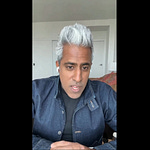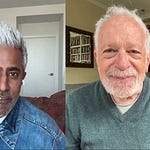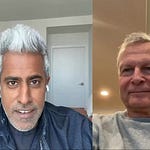If you’re only just tuning in, I recently announced that I’m serializing the opening chapters of my second book, “The True American,” over the coming days here. The introductory post explaining this virtual book club is here. Today, the fourth installment in the series.
LEAVINGS (continued)
The change began in a cramped apartment in New York, on the immigrant landing strip of Woodside, Queens. The area was thick with newcomers and with the longing for other places, the stores hawking phone cards and flags and nostalgic home-style sauces. Rais lived with a group of other men from Bangladesh, on one floor of a house near the corner of 59th Street and 37th Avenue. It was under the flight path into LaGuardia’s Runway 4-22, and Rais often found himself unable to sleep after 5 a.m. or thereabouts, thanks to the roaring, house-quaking engines above. He and his three flatmates, whom he’d met through Bengali circles in New York and two of whom he happened to know of back home, first rented the basement for about $1,000 a month for all of them. Then they upgraded to the top floor for $1,500 or so.
The guys teased Rais for his phone calls to Abida, seeking what Rais jokingly called “cook support.” When it was his turn to feed the house, he would sometimes dial her from in front of the stove, asking for help. Abida taught him how to curb the pungency of buffalo fish or tilapia using turmeric, lime, and water. She instructed him to hold his knife above the stove flame before cutting onions, in order not to cry.
He had finally arrived in New York in 1999, twenty-five years old, with a vague interest in IT but firm plans to study commercial aviation, which was more in keeping with his background. At first, he worked a series of part-time jobs to make ends meet. His flat-mate who worked at a gas station told Rais about an opportunity doing the graveyard shift there: Rais could take daytime classes and study behind bulletproof glass at night. So Rais did that for a few months, changing buses twice to get to work, sleeping just two or three hours a night. When that job drained him, he found another short-lived one at a copy store in Manhattan. He also tried being a busboy at a thriving French restaurant in Midtown but burned out after a single twelve-hour shift spent entirely on his feet.
Even before Rais could enroll in an aviation class, a friend of his, also ex–Air Force and now in New York, tried to convince him to switch to IT. He knew Rais loved computers and coding. He argued to Rais that technology was turning so many professions, including in aviation, obsolete. Why train to be a pilot when computers will soon fly planes? Much better to learn how to operate those computers.
When Rais had a goal clenched in his jaw, no one could tear it from him. But for someone so gritty, he was also easily persuaded by advice not to release an ambition so much as upgrade to a juicier one. So it was with his friend’s suggestion: “I thought that would be nice, if I could go start a different career, different track.” Rais was one of those fleet-footed men who look in the mirror and see only future incarnations of themselves. He decided to enroll in a full-time course in computer studies at Pace University, housed in a giant concrete compound near City Hall in Lower Manhattan.
But the visa that Rais had — the M-1, for vocational training — was different from the F-1 he needed to enroll as a full-time student. He had to leave the country and reapply. When he did so, after crossing over to Vancouver late in 1999, the embassy rejected him. He returned to New York for a few months, stranded in his plans.
Some friends of his had applied for something called the Diversity Visa. It was part of a program to admit immigrants from places that sent relatively few people to America. The program employed a lottery, choosing about fifty thousand winners out of several million applicants. The chance of making it was, on average, less than 1 percent. For those who did, the visa paved the way to a green card and permanent residency. Rais decided to apply.
Application submitted, he returned home to Bangladesh in February 2000. He had hoped it might be possible to marry Abida at this time. However, Abida’s sister had died during childbirth just before he arrived. “That’s not the time for going to wedding approach,” Rais concluded.
Rais sensed that Abida’s feelings for him remained strong, but her mother continued to lobby her otherwise. It was strange: Rais went over to their house on this trip, and the mother fed him and was unfailingly kind to his face. Behind the scenes, for reasons he never could understand (or perhaps didn’t want to), she was pulling Abida in another direction. Abida, though, seemed resilient in her devotion. The young couple pined for each other, and on this visit a day without meeting gave them a sinking feeling. Rais’s bedroom window looked into the kitchen window at Abida’s, and Rais often checked to see if he could find Abida cooking and say hello through the layers of glass. On this visit, as before he left, Rais hung a few magnets on a nail on his door, where Abida could see them, as his signal to her that he was out of the house. He would remove the magnets when he returned, so that she knew he was safe. Abida, too, placed magnets — on the iron bars girding the kitchen window — and removed them upon returning home.
Their love renewed but a wedding date still elusive, Rais returned to New York. Out of nowhere, he soon learned that he had won a Diversity Visa. “A new chapter opened that day for me,” he said. It was more than just a visa. In the hands of a man so ready for reinvention, it was an invitation to a wholesale change of life plan. Student visas, by definition, only allowed one to study in the country. Rais would have had to return home after finishing, or get an employer-sponsored visa in order to work and remain in the States; and, since they were unmarried, it would have been hard to get a visa for Abida. The Diversity Visa created a path both for his spouse to join him in America and for him to work indefinitely. And because Rais so easily reimagined himself, he resolved now that he would make a life in America. He would forget about Biman, fly home to marry Abida late in 2001, whisk her to New York, and make an American existence with her.
Without Abida’s having much say in the matter, her life trajectory was swerving. And now it swerved again.
Back in New York, Rais decided to go on a trip. Before leaving for Dhaka, he had received a phone call from a man it took him a moment to place. The man called himself Salim and said he’d been a few years ahead of Rais at Sylhet. Rais remembered now: he’d been a friendly guy. Salim had heard of Rais’s living in America from a common friend. On the phone Salim was instantly familiar in the American way, and he suggested that Rais pay him a visit in Dallas, Texas. Rais didn’t know it yet, but in Salim’s line of work, one was ever seeking fresh, hardworking immigrants whom you could trust.
The thing about Dallas, Rais found when he visited Salim, was that the bathrooms there were as big as his bedroom in New York. The city somehow enchanted him. New York was, if you thought about it, not unlike Dhaka — full of life, yes, but basically an overgrown bazaar, suffocating and dense. It was great for a single man who wanted only to work. But Dallas offered what Rais had begun to dream of as he drew closer to becoming a family man: space, freedom, twelve-lane roads. Rents were cheap and taxes low. Computer classes were abundant. It might not have appealed to him had he not won that Diversity Visa, but his calculations were now for building a family and for the long haul. America was no longer a training ground; it was home. In Texas, he could afford to study and pay his rent while working on the side; he could build a life for two and, with luck, more.
Not long after his visit, he called Salim from New York. “If I move to Texas, what I have there?” he asked. “How you can help me?” Salim, as it turned out, had much to offer. He and his brother were businessmen in Dallas, and they were opening a new gas station there. If Rais moved down, he could work as one of Salim’s partners; if he did well, he might own a gas station of his own before long. It was not glamorous, perhaps, but it would earn Rais money for the wedding and his studies. “Like a team, we’ll help each other,” Salim told Rais. There was enough trust between them that they didn’t talk about money. Rais planned to live in Salim’s house upon arriving.
The Dallas opportunity was Rais’s seventh victory in a row. What a streak it had been: Sylhet, then the Air Force, then the escape from the Air Force, then Abida, then a first visa and an improbable second, and now Dallas, Texas. All this helped Rais not to mind the long, smelly month of purging trash and scrubbing floors at the Buckner Food Mart, which had tumbled into disrepair before Salim bought it. Rais didn’t mind the petty thieves and the deadbeat refuelers; he even got used to the guns. His eyes were, as ever, on the horizon. He would save up for the flight back to Dhaka in October, and finally the wedding would happen. He told Abida, “You do some groundwork with your parents, so that they should not be blocking and blocking. Once I come, it should be, ‘OK, then let’s get the business done.’ ”
Even amid this excitement, Abida wanted Rais to know of her very real concerns. “First thing she was telling that, ‘That’s too far from New York. Do you really want to go to Texas?’ Back home, Texas was always wild, wild, with lot of gunshot, cowboys, this and that — from all the Western movies.” She urged him to rethink it: “Do you have to go? Can’t you stay in New York?”
But she also knew how little she knew, and Rais was adamant that this was the right move for them. He would have preferred New York were he thinking just for himself, he explained to her. The whole point of moving south was to build a life suitable for a family — their family. Rais had convinced himself, if not yet Abida, that he was going to Texas for her.
The above is the fourth of eight serialized excerpts from “The True American” that will appear in The Ink. Copyright 2014, W.W. Norton.
For the full book, find it below or wherever you get your books:
Indiebound
Audible audiobook
Amazon
W.W. Norton
Apple
Barnes & Noble
Books a Million
Bookshop.org

















Share this post